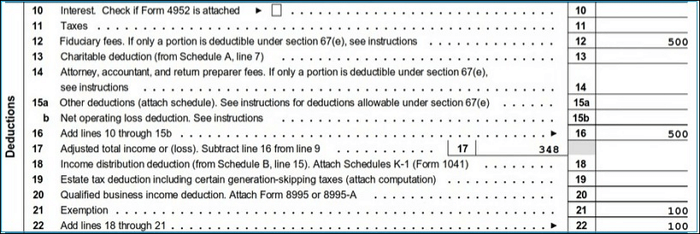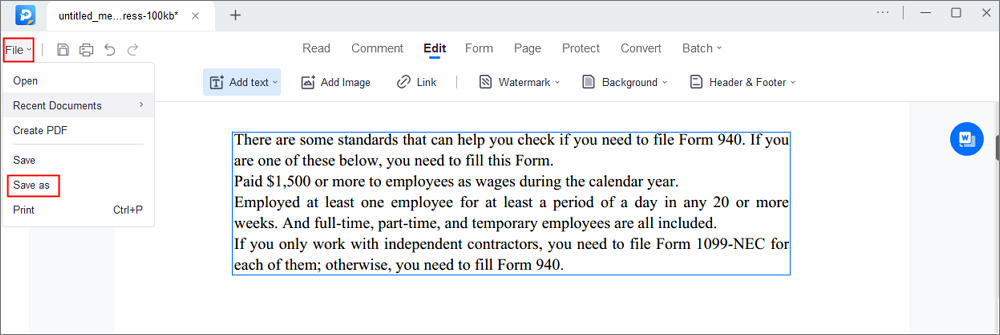- About
- Discover EaseUS
- Reviews & Awards
- License Agreement
- Privacy Policy
- Student Discount
Instructions for 1041 Tax Form| How to Fill Out This Form
Melissa Lee updated on Sep 19, 2025 | Home > PDF Knowledge Center | min read
Many fields or columns on Form 1041 may be confusing if you are looking to fill it out to declare your trust's or estate's income. Each year, the tax deadline is between 15 and 18 April, so you should complete Form 1041, including all the information you need to file your income tax return.
This article is focused on providing all the essential instructions that must be needed to fill out the form. Let's walk you through all the details you need to know.
What Is the 1041 Tax Form?
Form 1041 is an Internal Revenue Service (IRS) income tax return for Estates and Trusts. It is designed to report the income of an estate or trust from the time of the decedent's death. They must declare the income through this form until the assets are distributed to the beneficiaries. During this time, these trusts and estates can generate and organize payments as stocks, bonds, funds, etc. In addition, Form 1041 must also be filed if a beneficiary is a non-resident alien and the yearly income of the trust or estate is over $600.
- Notice:
- You should consult with an attorney or accountant familiar with trust income taxation if you are not sure to fill out this form.
If you need to fill 1041 Tax Form, please follow the next section.
Learn How to Fill Out a 4506 T Form for Tax Return Transcript
Being a United States Internal Revenue Service tax form, Form 4506-T is created to place transcripts or past tax return data.

How to Fill Out a 1041 Tax Form?
Actually, filling out a 1041 tax form is not difficult, and it's just like filling out form 1040 SR. Only if you follow the guide here, you will find it easy. You will have to complete this three-page form and be required to fill in the necessary boxes. A unique tax identification number (TIN) and employer identification number (EIN) are needed for an estate. During the filling process, please keep in mind that the deceased and their estate will be considered two separate entities.
Page 1
This page requires you to submit the basic details of the estate or trust arrangements, name, address, EIN, TIN, income, deductions, tax, or other expenses. You are also required to enter the name and titles of the personal representative, executor/administrator of the estate, or trust.
Income
Income is reported in columns 1 to 9 of the form. It includes dividends, capital gain, loss, royalty, rents, and partnerships.

Deductions
Deductions such as administrator costs that you are required to enter from lines 10 to 22. You need to fill in the details about charitable deductions, taxes, attorney, fiduciary fees, income distribution deductions, returns, and other deductions that your organization does.

Tax and Payments
You are needed to enter all the taxes and payment details from lines 23 to 30, including total tax amount, taxable income, net tax liability, beneficiaries' estimated tax payments, federal income tax, total payments, estimated tax penalty, tax due, and some other additional details.

Page 2
Let's move to the second page with three different schedules.
Schedule A: Charitable Deduction
- Notice:
- Skip this schedule if you fill out the form for a simple trust or a polled income fund.
You are required to enter details about capital income after excluding the funds for section 1202 for charitable purposes. It will help the government administration to calculate the total gross income by subtracting the amount in the 6th line from the 5th line.

Schedule B: Income Distribution Deduction
This section needs to be filled with the details of the distribution deduction of the income of your trust or estate. You will have to provide valid answers related to the adjusted total income or tax-exempt interests, net income, etc. In short, you need to document all the aspects where your income is distributed. Whenever you receive a profit, you must show it as a negative value, whereas you receive a loss, you must show it as a positive value.
Schedule G Tax Computation
This Schedule G section is divided into two parts that are required to fill out the information about Tax Computation and payments. Provide all the necessary details about tax, foreign tax credits, general business credits, and the Net investment income tax.

Bonus Tip: A Wonderful Tool to Fill Out Form
Finally, when you have understood how to fill out the 1041 tax form, we would like to introduce you to an excellent PDF form filler to make the process easier and submit all the information correctly. EaseUS PDF Editor is a one-stop solution that makes the form-filling process hassle-free and saves effort and time. By using EaseUS PDF Editor, you can edit and fill many kinds of forms like form 8332, form 2848, etc
This software is packed with bloated features that you probably not find anywhere else. It has an easy-to-use interface with the best PDF editing features to provide better solutions without putting a load on your pocket.
Here are some key features of EaseUS PDF Editor:
- Quick and easy-to-use interface
- Scan or OCR a PDF to edit content
- Effortless working and editing ability on any document
- Support for converting PDFs to other prominent formats
- Manage and password protect PDF Files painlessly
Here are the steps you can follow to use this tool:
Step 1. Launch EaseUS PDF Editor and click "Open" to import the PDF file you want to edit.

Step 2. When the file is opened, you can see many editing tools, including "Read", "Comment", "Edit", "Form", "Page", "Protect", "Convert", etc. Choose any one you like.

Step 3. After editing, click "File" > "Save as" to save the edited PDF to your computer.

Conclusion
Administrating an estate may require you to fill out or hire someone else to fill out Form 1041. The significant paperwork of filling out the 1041 tax form comes with some unexpected responsibilities, including the review of essential paperwork. If you are a beginner in filling out this form, you must read all the mentioned instructions carefully. In addition, it is advisable to use EaseUS PDF Editor if you want to quickly edit or share the PDF version of the 1041 form.
FAQs on 1041 Tax Form
To know more details about this topic, you can refer to the FAQs on the 1041 tax form below:
1. Do I need to file 1041 if no income?
You do not need to file Form 1041 if there is less than $600 of gross income and no taxable income.
2. Are funeral expenses deductible on 1041?
No. A decedent's estate executor must use Form 706 to calculate the estate tax due for a deceased person. Funeral expenses are deductible only on Form 706.
3. What happens if you don't file 1041?
It is mandatory to fill out the 1041 form if the income of an estate or trust is more than $600. Non-filings can be penalized with 5% of the tax due each month up to a maximum of 25%.
About the Author
Melissa Lee is a sophisticated editor for EaseUS in tech blog writing. She is proficient in writing articles related to screen recording, voice changing, and PDF file editing. She also wrote blogs about data recovery, disk partitioning, and data backup, etc.

![Can Kindle Read PDF [2025 Updated]](/images/pdf-editor/en/related-articles/6.jpg)
![[Form 941 Instruction for 2025] How to Fill Out Form 941](/images/pdf-editor/en/related-articles/39.jpg)